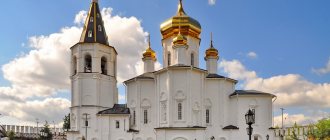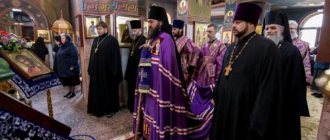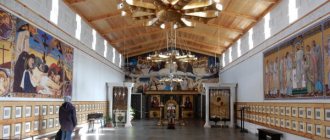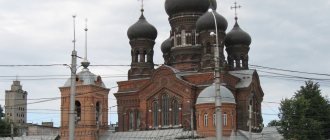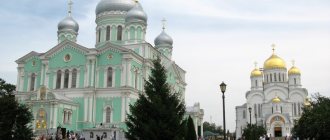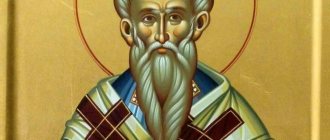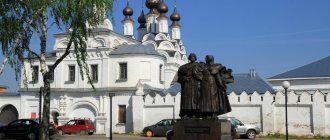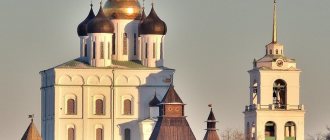History of writing the icon
This amazing icon was painted by Metropolitan Peter of Moscow in 1320.
After the Union of Brest, the icon was placed in the Yeletsky Chernigov Monastery. It was this icon that blessed the construction of the Surazh monastery. When the Surazh monastery was established near the city of Surazh, His Grace Anthony Stakhovsky gave this icon to the builder of the monastery, Simeon.
In the cathedral church of this monastery, now no longer existing, there stood the holy Novodvorskaya icon.
In 1677, on August 14, the icon was transferred from the old church to the new one in a procession before the liturgy.
The prototype of the Novodvorskaya Icon of the Mother of God was painted by St. Peter, Metropolitan of Moscow, presumably in 1320.
The icon is a half-length image of the Mother of God with the Child on her left hand; their heads are decorated with crowns.
While still a hieromonk of a monastery in Volyn and having asked for the blessing of the abbot, Peter left the monastery in search of a secluded place. On the Rati River, near a tract called the New Palace, he set up a cell and began to asceticize in silence. Subsequently, a monastery called Novodvorsky was formed on the site of his exploits.
After the signing of the Union of Brest, during the persecution of the Uniates who plundered the Novodvorsky Monastery, the holy icon was transferred by a certain hieromonk Jacob to the Chernigov Yeletsky Holy Dormition Monastery.
Then the Eminence of Chernigov Anthony (Stakhovsky) blessed Simeon, the builder of the Surazh monastery (abolished in 1766), with this icon. On August 14, 1677, during the procession of the cross from the old church to the new, the holy image of the Mother of God showed miraculous signs. Saint Demetrius of Rostov, who arrived at that time to venerate the miraculous icon, witnessed that Bishop Nicodemus of Tseler after the Liturgy on August 16 announced these miracles to the assembled believers.
Subsequently, the miraculous Novodvorsky image of the Blessed Virgin Mary stayed in the Novgorod-Seversky Spaso-Preobrazhensky Monastery, which was closed in the late 50s of the 20th century. The very prototype of the holy icon was lost during the hard years.
One of the monks of the abolished monastery transferred the list from the miraculous image to the city of Nizhyn, and in 1997 it was transferred to the local Church of the Exaltation of the Cross. In 2000, the Novodvorskaya Icon of the Mother of God was placed in an icon case; every Sunday before the miraculous image, an akathist to the Intercession of the Most Holy Theotokos is served.
Other copies of the miraculous Novodvorskaya Icon of the Mother of God were in the Kamensky Assumption Convent of the Novozybkovsky district of the Chernigov province and in the Kiev Golden-Domed St. Michael's Monastery.
In 2004, during a visit to the Spaso-Preobrazhensky Novgorod-Seversky Monastery by the presidents of Russia, Ukraine and Belarus, a copy of the miraculous icon, written in the 18th century, was donated to the monastery.
In the Church of the Martyrs Adrian and Natalia there is a copy of the Novodvorskaya Icon. It was brought as a gift to the temple in 1969 by parishioner Elena Mikhailovna Sokolova. According to Elena Mikhailovna’s story, her ancestor, the Turk Ahmed Oglu, was captured during the Russian-Turkish War. He remained in Russia and converted to Orthodoxy. His godfather miraculously found this list and gave it to the newly converted Christian.
The icon is located on the southern wall of the temple, to the left of the entrance to the vestibule for holy water.
The icon is commemorated on January 2 (December 20, old style) . According to established tradition, in our church the icon is also honored on January 1 (December 21) . On this day, a prayer service with an akathist is served before her.
Miraculous list of icons in the Kamensky Assumption Monastery
A particularly revered ancient copy of the icon was located in the Kamensky Assumption Convent of Novozybkovsky district.
It was given as a blessing to the monastery at its founding in 1687 by Archbishop Lazar Baranovich.
On June 26, 1889, the Assumption Church in the Kamensk monastery was severely damaged by a thunderstorm. Lightning caused a lot of damage inside the temple, but the Novodvorskaya icon remained completely unharmed.
In memory of this, on June 26, a religious procession is held with the sacredly revered icon.
Catalog of icons on the website PravIcon.com
Description of the Novodvorskaya icon
Source: Disc “Orthodox Church Calendar 2011” from the publishing house of the Moscow Patriarchate [2011]
The prototype of the Novodvorskaya Icon of the Mother of God was painted by St. Peter, Metropolitan of Moscow (December 21), presumably in 1320. While still a hieromonk of a monastery in Volyn and having asked for the blessing of the abbot, Peter left the monastery in search of a secluded place. On the Rati River, near a tract called the New Palace, he set up a cell and began to asceticize in silence. Subsequently, a monastery was formed on the site of his exploits, called Novodvorsky. After the signing of the Union of Brest, during the persecution of the Uniates who plundered the Novodvorsky monastery, the holy icon was transferred by a certain hieromonk Jacob to the Chernigov Yeletsky Holy Dormition Monastery. Then the Eminence of Chernigov Anthony (Stakhovsky) blessed Simeon, the builder of the Surazh monastery (abolished in 1766), with this icon. On August 14, 1677, during the procession of the cross from the old church to the new, the holy image of the Mother of God showed miraculous signs. Saint Demetrius of Rostov, who arrived in […]
Icon of Novodvorskaya - description
Source: Website “Miracle-Working Icons of the Blessed Virgin Mary”, author - Valery Melnikov [2011]
According to legend, the icon was painted by St. Peter, the future Metropolitan of Moscow and All Russia around 1320, when he still lived in Volyn, in the monastery he founded , on the Rata River, on a tract called the New Palace. During the fight against the union (the merger of the Orthodox and Catholic faiths), the local hieromonk Jacob transferred the holy icon to the Chernigov Yeletsky Assumption Monastery. Over time, the shrine was moved to Novgorod-Siversky, to the Spaso-Preobrazhensky Monastery, where it was revered along with another miraculous icon of the Most Holy Theotokos - “SAVIOR OF THE DROWNING” (LENKOVSKAYA). In Soviet times, the icon was lost. In 2004, the presidents of Russia, Belarus and Ukraine took part in the consecration of the revived Spaso-Preobrazhensky Monastery. An ancient copy (copy) of the Novodvorskaya Icon of the Blessed Virgin Mary was given to the monastery as a gift. Another miraculous ancient copy of the Novodvorskaya icon was revered in the Holy Trinity Convent of the city of Kursk. This ancient image is still found[...]
Description of the Novodvorskaya icon from the book by E. Poselyanin
Source: Book “E.
Villager. Our Lady. Description of Her earthly life and miraculous icons" [1914] According to legend, the miraculous icon of the Mother of God, called Novodvorskaya, was painted by St. Metropolitan Peter at the beginning of the 14th century. This image is called so because at the time of its writing, Saint Peter was in Volyn, in a now abolished monastery, built on the banks of the Rati River, in the New Palace tract. After the Novodvorsk monastery was captured by the Uniates, Hieromonk Jacob transferred this icon to the Chernigov Dormition Yeletsky Monastery. When the now abolished Surazhetsky monastery was founded in the Chernigov province, near the city of Surazh, His Grace Anthony (Stakhovsky) gave the Novodvorskaya icon as a blessing to the builder of the monastery, Simeon. In this monastery the image was placed in the cathedral church. In 1677, on August 14, the Belarusian Bishop Theodosius (Vasilievich), in a procession before the liturgy, transferred the Novodvorskaya icon from the old cathedral monastery church to the newly created temple of the same Surazhetsky monastery. Saint Demetrius of Rostov, who was at this celebration, says that in the church[...]
List of icons in the Kiev Golden-Domed St. Michael's Monastery
The Kiev Golden-Domed-Mikhailovsky Monastery also houses the revered Novodvorskaya icon - an exact copy of the miraculous one. On the Novodvorskaya icon, the Mother of God, holding the Savior on her left hand, is depicted wearing a crown, and there is also a crown on the head of the Infant God.
It is currently unknown where the icon of the Mother of God, painted by Metropolitan Peter and located in the Surazhitsky Monastery, is located. And the Surazhitsky Annunciation Monastery itself was abolished in 1786. Celebration of December 20 (January 2, new style).
Author:
Tatiana
We publish in the telegram earlier than on the website. Subscribe to the Pravlife Channel
Icon of the Mother of God SURAZH
Icon of the Mother of God SURAZH
Icon of the Mother of God of Surazh (Novodvorskaya)
(XIV century, celebration December 20/January 2)
The miraculous icon of the Mother of God, called Novodvorskaya, was painted by Saint Peter, Metropolitan of Moscow and All Rus', around 1320, when he was in Volyn in the monastery he built on the banks of the Rati River, on the New Palace tract. When the Novodvorsky Monastery was captured by the Uniates, Hieromonk Jacob transferred the icon to the Chernigov Dormition Eletsky Monastery. In 1677, on August 14, the image was transferred by the Belarusian Bishop Theodosius from the old church to the new one in a religious procession before the Divine Liturgy. St. Demetrius of Rostov (+1709), who arrived at that time to venerate the miraculous image, said that on August 16, Nicodemus, Bishop of Tseler, announced in the church after the Divine Liturgy, the miracles that took place during the procession from the icon of the Mother of God. In 1720, with the blessing of Archbishop of Chernigov Anthony (Stakhovsky, 1713-1721), Hieromonk Simeon (Lushchinsky), who came from Poland, and the convoy of the Starodubsky regimental Athanasius Yesimontovsky, the Annunciation Monastery was founded newly established the city of Surazh, Chernigov province, across the Iput River.
The Right Reverend Anthony gave the Novodvorskaya icon to the builder of the monastery, Hieromonk Simeon, and it was placed by him in the cathedral church. In 1786, the Annunciation Monastery was abolished, its wooden church was moved to the city of Surazh and became a parish church. The miraculous Novodvorskaya icon was transferred to the Novgorod-Seversky Spassky Monastery. In the Surazh Church, a copy of the Novodvorskaya icon was painted, which was located on the left side of the iconostasis in an ancient silver gilded icon case and was very revered by the parishioners. According to other sources, the miraculous image itself remained in the Surazh temple.
A particularly revered ancient copy of this icon was located in the Kamensky Assumption Monastery of the Novozybkovsky district of the Chernigov province (now the Klimovsky district of the Bryansk region). This monastery was founded in 1687 by Hieromonk Jonah. Archbishop Lazar (Baranovich) of Chernigov gave his cell Novodvorsk Icon of the Mother of God as a blessing to the newly built monastery. In 1899, the Assumption Church of the monastery, in which the Holy Icon was located, was significantly damaged by a lightning strike, but the icon remained unharmed. In memory of this wonderful event, every year on June 26, a religious procession was held at the monastery with the revered icon of the Mother of God. Under the Soviet regime, the monastery was almost completely destroyed. Another especially revered copy of the Novodvorskaya icon was located in the Kiev Golden-Domed St. Michael's Monastery.
Now it is unknown where the icon of the Mother of God painted by St. Peter is located. The Surazh Annunciation Church was barbarically destroyed after the Bolshevik revolution. In its place there is now a dance floor in the park. The street on which the temple was located was also called Blagoveshchenskaya (now named after Voroshilov). During the destruction of the temple, one of the icons was saved by one of the city residents. When the Great Patriotic War began, many Surazhan residents were evacuated, leaving their homes. The pious servant of God Natalia, who remained in the city with her mother, says: “We bought firewood in one of the abandoned houses, and when we loaded it, we discovered an icon of the Mother of God embedded in the firewood and Church coverings embroidered in gold. We gave the intercessions to the temple, which still existed then and was located in the place where the district administration is now. But I couldn’t part with the icon. She begged her mother to let her leave her at home. Over time, the image darkened and the faces became difficult to distinguish. In the early 1990s, the icon began to lighten and the inscription became visible.”
The analogue icon of the Mother of God of Novodvorskaya was brought to the newly built church in Surazh in honor of the Annunciation of the Most Holy Theotokos, on which the following inscription was preserved: “An image of the icon of the Most Holy Theotokos Miraculous called Novodvorskaya, now located in the Diocese of Chernigov in the Annunciation Surazhskaya Church. February 17, 1866."
Novodvorsk icon what to pray for
The prototype of the Novodvorsk Icon of the Mother of God was painted by Saint Peter, Metropolitan of Moscow (December 21), presumably in 1320. While still a hieromonk of a monastery in Volyn and having asked for the blessing of the abbot, Peter left the monastery in search of a secluded place. On the Rati River, near a tract called the New Palace, he set up a cell and began to asceticize in silence. Subsequently, a monastery was formed on the site of his exploits, called Novodvorsky
After the signing of the Union of Brest, during the persecution of the Uniates who plundered the Novodvorsky Monastery, the holy icon was transferred by a certain hieromonk Jacob to the Chernigov Yeletsky Holy Dormition Monastery.
Then the Eminence of Chernigov Anthony (Stakhovsky) blessed Simeon, the builder of the Surazh monastery (abolished in 1766), with this icon. On August 14, 1677, during the procession of the cross from the old church to the new, the holy image of the Mother of God showed miraculous signs. Saint Demetrius of Rostov, who arrived at that time to venerate the miraculous icon, witnessed that Bishop Nicodemus of Tseler after the Liturgy on August 16 announced these miracles to the assembled believers.
Subsequently, the miraculous Novodvorsky image of the Blessed Virgin Mary stayed in the Novgorod-Seversky Spaso-Preobrazhensky Monastery, which was closed in the late 50s of the 20th century. The very prototype of the holy icon was lost during the years of hard times.
One of the monks of the abolished monastery transferred the list from the miraculous image to the city of Nizhyn, and in 1997 it was transferred to the local Church of the Exaltation of the Cross. In 2000, the Novodvorskaya Icon of the Mother of God was placed in an icon case; every Sunday before the miraculous image, an akathist to the Intercession of the Most Holy Theotokos is served.
Other copies of the miraculous Novodvorskaya Icon of the Mother of God were in the Kamensky Assumption Convent of the Novozybkovsky district of the Chernigov province and in the Kiev Golden-Domed St. Michael's Monastery.
In 2004, during a visit to the Spaso-Preobrazhensky Novgorod-Seversky Monastery by the presidents of Russia, Ukraine and Belarus, a copy of the miraculous icon, written in the 18th century, was donated to the monastery.
The Novodvorskaya icon of the Most Holy Theotokos is a half-length image of the Mother of God with the Divine Child on Her left hand, the heads of which are decorated with crowns.
The prototype of the Novodvorskaya Icon of the Mother of God was painted by St. Peter, Metropolitan of Moscow, presumably in 1320.
The icon is a half-length image of the Mother of God with the Child on her left hand; their heads are decorated with crowns.
While still a hieromonk of a monastery in Volyn and having asked for the blessing of the abbot, Peter left the monastery in search of a secluded place. On the Rati River, near a tract called the New Palace, he set up a cell and began to asceticize in silence. Subsequently, a monastery called Novodvorsky was formed on the site of his exploits.
After the signing of the Union of Brest, during the persecution of the Uniates who plundered the Novodvorsky Monastery, the holy icon was transferred by a certain hieromonk Jacob to the Chernigov Yeletsky Holy Dormition Monastery.
Then the Eminence of Chernigov Anthony (Stakhovsky) blessed Simeon, the builder of the Surazh monastery (abolished in 1766), with this icon. On August 14, 1677, during the procession of the cross from the old church to the new, the holy image of the Mother of God showed miraculous signs. Saint Demetrius of Rostov, who arrived at that time to venerate the miraculous icon, witnessed that Bishop Nicodemus of Tseler after the Liturgy on August 16 announced these miracles to the assembled believers.
Subsequently, the miraculous Novodvorsky image of the Blessed Virgin Mary stayed in the Novgorod-Seversky Spaso-Preobrazhensky Monastery, which was closed in the late 50s of the 20th century. The very prototype of the holy icon was lost during the hard years.
One of the monks of the abolished monastery transferred the list from the miraculous image to the city of Nizhyn, and in 1997 it was transferred to the local Church of the Exaltation of the Cross. In 2000, the Novodvorskaya Icon of the Mother of God was placed in an icon case; every Sunday before the miraculous image, an akathist to the Intercession of the Most Holy Theotokos is served.
Other copies of the miraculous Novodvorskaya Icon of the Mother of God were in the Kamensky Assumption Convent of the Novozybkovsky district of the Chernigov province and in the Kiev Golden-Domed St. Michael's Monastery.
In 2004, during a visit to the Spaso-Preobrazhensky Novgorod-Seversky Monastery by the presidents of Russia, Ukraine and Belarus, a copy of the miraculous icon, written in the 18th century, was donated to the monastery.
The Church of the Martyrs Adrian and Natalia is the only one in Moscow where there is a list of the Novodvorskaya icon. It was brought as a gift to the temple in 1969 by parishioner Elena Mikhailovna Sokolova. According to Elena Mikhailovna’s story, her ancestor, the Turk Ahmed Oglu, was captured during the Russian-Turkish War. He remained in Russia and converted to Orthodoxy. His godfather miraculously found this list and gave it to the newly converted Christian.
The icon is located on the southern wall of the temple, to the left of the entrance to the vestibule for holy water.
The icon is commemorated on January 2 (December 20, old style). According to established tradition, in our church the icon is also honored on January 1 (December 21). On this day, a prayer service with an akathist is served before her.
The celebration of the Novodvorskaya Icon takes place on January 2 (December 20, old style).
What they pray to the Novodvorsk Icon for: they pray for special intercession and favor towards the place where the person is; about protection during persecution; about consolation in times of grief; about stopping the fires.
O All-Merciful Lady, Virgin Mother of God! Hear our humble prayer, and hear the voice of those now contritely approaching Your image. We know, O our Creator Mother, that You are the shameless intercession of Christians and the immutable intercession to the Creator: we also know that our iniquities have exceeded our heads and that a heavy burden has burdened us, and we are no longer worthy to see the heights of heaven, look lower to the Throne the glory of Your Son and our God, but worthy of the appearance of torment and eternal condemnation. For this reason, we fall to You, we ask You tenderly, we cry to You with tears: lift up Your Motherly prayer to Him, so that He will not reject us sinners from His presence, but as He is merciful, may He forgive us our sins, voluntary and involuntary, guiding us on the path of salvation and with the power from above to the creation of His commandments, strengthening: may He preserve us from the temptations of the world, from sinful lusts, from the snares of the devil and from the attacks of visible enemies: may He bless the works of our hands, giving to this city or this village, or this holy monastery and to every city and the country an abundance of earthly blessings, may He create good and serene days for all of us: may He protect His holy Church with peace, and may it unite the dispersed one, for the Lord is good, long-suffering and abundantly merciful, glorified from all creation with the Father and the Holy Spirit forever and ever. Amen.
KURSK MONASTERY IN THE NAME OF THE HOLY TRINITY
It was first mentioned in the scribe books of 1628-1631: “... in the settlement, behind the large old fort, there is the Maiden Monastery, and on the monastery there is the Church of the Life-Giving Trinity with the chapel of the Renovated Church of the Resurrection of Christ, wooden, there are 21 cells in it, 35 nuns; and near the monastery of uncultivated artisans and peasants there is a settlement, and five cells for the poor; in the small fort there is a siege courtyard, which Abbess Sundulia and her sisters bought from the Cossack Afanasy Sopin for refuge during the siege” (Larionov. 1786. p. 19). Mon-ry owned villages with 26 peasant and bobyl households, in the city he owned 2 settlements, in which there were 131 and 119 households, where there were 304 people. husband. floor. The population of the settlements consisted of artisans (blacksmiths, potters, tailors, shoemakers) and traders (Kursk: Essays. 1957. P. 17). The mentioned abbot. Snandulia was probably the first abbess of the monastery (Emilia (Lebedeva). 1912. P. 19). In 1634, the monastery settlement was burned by the Polish. troops under the command of Prince. Jeremiah Mikhail Koribut-Vishnevetsky, but already in 1646 it consisted of 119 households.
Kursk Monastery in the name of the Holy Trinity. Photo. 10s XXI century Kursk Monastery in the name of the Holy Trinity. Photo. 10s XXI century
According to legend, in a fire in 1680 all the buildings of the monastery burned down, but in 1681, under the abbot. Pelagia, in K. m. a wooden church was built in the name of the Holy Trinity with a chapel in memory of the Renewal of the Church of the Resurrection of Christ. In 1695, a stone 2-story Holy Trinity Cathedral with a lower center was founded and soon erected in K. m. in honor of the Smolensk Icon of the Mother of God “Hodegetria”. For some time, the monastery church was a parish church: the laity went only to the upper Trinity Church, and the monastics - to the lower one.
In 1722, according to the report of Abbot. Barbarians to the Synod, 41 nuns lived in K. m., including 35 nuns, government salaries, rugs, the monastery did not have (ODDS. T. 2. Part 1. pp. 406-407); in the 20s XVIII century 2 schema-nuns are mentioned: Mariamne (77 years old) and Taisiya (79 years old) (RGADA. F. 350. Op. 1. D. 215. L. 273). According to the audit of 1744, in the monastery estate - the village. Pokrovsky - 464 peasants lived, who supplied hemp oil, eggs, and flax to the monastery. The monastic arable land amounted to 72 dessiatinas. The peasants caught fish for the monastery in the river. Seven (Seim) (Dyudina. 2008. P. 104). In 1787, Emperor. Catherine II, when visiting Kursk, donated 300 rubles to the monastery. Two blocks from K. m. stood the house of merchants I. I. and A. F. Moshnin, who probably visited the monastery with their son Prokhor (St. Seraphim of Sarov).
In 1764, K. m. was enrolled in the third-class category. Under the abbess (1762-1765) abbot. Metropolitan (Dolgintseva; † 31 Dec. 1765) 15 nuns lived in K. m., 2 priests served: John Matchin and Mikhail Nifontov, sexton Mikhail Matchin, sexton Vasily Kalmykov, as well as carpenter Dmitry Soinikov, cooper Fyodor Soinikov and tailor Vasily Guselnikov . In the 70s XVIII century The Trinity Church was renovated, the decoration was decorated with stucco images: in the dome - the Lord of Hosts, on the sides - angels and 4 evangelists in sails. In 1773-1774, under abbot. Epistimia, lower c. in honor of the Smolensk Icon of the Mother of God it was updated; in the end XVIII century, under abbot. Afanasia, from the west. a stone fence was built on the side of the monastery; in 1818, under abbot. Anfia (Navrotskaya), cast for the monastery bell tower to replace the broken bell, 194 pounds; in 1829, under abbot. Dosithea, the abbot's cells have been built. According to the plan of 1822, K.'s possessions extended to 40 fathoms. in length and 53.5 fathoms. in width. In 1824, the collegiate secretary S.G. Gladkov donated a house and garden adjacent to Mont-Rue from the southeast to the benefit of K. m. sides. In 1827, E. M. Speshneva transferred land from the north to the monastery. sides, on which later. the prosphora and abbot building were built, in 1829 E.K. Kopteva donated 2 houses with an outbuilding. In 1832, under abbot. Tabitha, a stone fence and St. gate at the entrance to the monastery with 2 small cells on the sides.
In 1836, on the initiative of the abbess (1831-1849), abbot. Tabitha († 1867) to the west. A warm church was built on the wall of the Trinity Church in honor of the monastery shrine - the Novodvorskaya Icon of the Mother of God. From the north and south On the sides of the warm temple, corridors were built that served as the entrance to the upper Trinity cold church. Kursk merchant widow A.I. Gladkova donated 5,000 rubles. banknotes for the construction of a warm church. According to legend, one day K. m. was visited by a wanderer who, looking at the monastery Novodvorskaya icon, fell in prayer before it with tears. Then the woman said that, having already lost hope of recovery, one day in a dream she saw an icon of the Mother of God, who promised her complete healing if she found the image. Having received relief from her illness, the woman wandered in search and, having found this icon in K. m., was finally healed. In memory of the miracle revealed by the Novodvorskaya icon, the altar of the newly built church was consecrated, and the image was placed behind the right choir. In 1851, 2 chapels were built in the Novodvorsky Church: the northern one - in memory of the appearance of the Iveron Icon of the Mother of God and the southern one - in the name of St. Mirona. Under the temple there were several. cell. With abbot. Alevtina made silver gilded robes for the local icons of the Savior and the Mother of God in the Novodvorskaya Church.
In 1849-1865. K.M. was headed by the abbot. Alevtina (Nedelskaya), tonsure of Borisovsky in honor of the Tikhvin Icon of the Mother of God of the monastery, cell attendant of the abbot. Anatolia (Yanovskaya), a student of the Optina elder Lev (Leonid) (Nagolkina). In 1851, K. m. occupied a space 71 fathoms long. and width 37 fathoms. “On this very limited plot of land,” wrote the abbot. Alevtina in a petition addressed to Archbishop of Kursk. Iliodor (Chistyakova), - there is a stone two-story temple in the name of the Life-Giving Trinity and 37 cells, which house 398 female souls who dedicated themselves to serving God in a solitary life.” In 1860 to the Trinity Church. chapels were added: in the southern one they consecrated the altar in honor of the Nativity of St. John the Baptist, and in the northern one they set up a sacristy.
27 Sep. 1852 at the request of the abbot. Alevtina, a monastery hospital for 10-12 beds was opened under K. M., in the organization of which the Kursk Trusteeship for the Poor Clergy took part, sending 1 thousand rubles. for the purchase of a house and annually transferred 300 rubles to the hospital. Archbishop of Kursk Iliodor donated 500 rubles, landowner A. A. Nelidov bequeathed to pay 200 rubles for the needs of the hospital. annually. On June 29, 1853, an almshouse for 8 elderly sisters was opened in K. m. Initially, it was located in cells under a warm church; later it was transferred to a new monastery building.
18 letters from the Optina elder St. Makaria (Ivanova) abbot. Alevtina (RGB. F. 213. K. 76. Item 11). In 1865, abbot. Alevtina was buried in the north-west. corner of the Smolensk Church.
Aug 29 In 1865, Monk was ordained to the rank of abbess. Sofia (Stupina; 1817-1909), student of the Optina elders, including St. Leonid (Nagolkina). During her abbotship, by 1892, 425 sisters lived in K. m., the monastery reached its greatest prosperity. Here the blind elder Rachel (in the schema of Seraphim), who had the gift of clairvoyance, and the sacristan monk labored. Piama († 1878), mon. Eliconidas, who was distinguished by her unusually meek attitude towards her sisters, schema. Alexandra († 1895) and mon. Angelina († 1895). In the north-east In the corner tower of the K. m. fence lived the holy fool Evdokia Alekseevna Rastorgueva (1790-1870).
In 1870, a copy of the Tikhvin Icon of the Mother of God, which belonged to the Trubitsyn family, was donated to the K. m. According to legend, one day the Trubitsyns moved from one estate to another and took with them the Tikhvin icon, which was covered with canvas. On the way, it began to rain, a strong wind rose, the glass on the icon broke, and the wet canvas hit the face of the Mother of God. Upon arrival at the place, it was discovered that the face of the Mother of God had been washed away. A painter was immediately invited and placed in the room where the icon stood. At night he woke up from the light emanating from the image of the Mother of God. The painter lost consciousness, and when he woke up, the light had disappeared. Approaching the image, he saw that the face of the Mother of God no longer needed correction: the icon itself had been renewed. Nikolai Trubitsyn gave the miraculous image to the Kursk Root Church in honor of the Nativity of the Most Holy One. Our Lady of the Deserts. After the death of Nikolai, his wife, E. N. Trubitsyna, entered the K. m. and took monastic vows as a ryassophore with the name Leonidas. The ancient icon was located in the Novodvorsky temple on the right side. On June 15, 1881, the icon of the Mother of God “It is Worthy to Eat” was brought from Athos to Kursk. With the blessing of the abbot. Sophia, it was placed in the Novodvorsky Church on the left side in a carved gilded icon case, in 1883 it was decorated with a silver gilded chasuble.
In 1883 in the village. Shuklinka, 7 versts from Kursk, on land donated by the merchant D. Sozonov, the Alexander Nevsky monastery was built. Aug 26 1891 in the monastery of the Kursk bishop. Justin (Okhotin) consecrated the stone church. in the name of St. Alexander Nevsky and Equal Apostles. Mary Magdalene with a bell tower (in memory of the deliverance of Emperor Alexander III and his family from the danger that threatened them during a train crash on October 17, 1888 at Borki station). The benefactors of the church-monument were the Kursk nobles, who collected money for the purchase of altar decorations, as well as the nun Lydia, who donated 3 thousand rubles. for the construction of the temple. Kursk educational institutions also made their contribution. The consecration was attended by the director husband. gymnasium D. G. Zhavoronkov (1821-1901; honorary citizen of Kursk, buried in the monastery fence), general. N.I. Chagin et al. September 25 In 1903, a warm skete church was consecrated in the name of St. Nicholas the Wonderworker. 28 Sep. In 1898, a skete monastic almshouse for 10 elderly nuns was consecrated. In 1909, a well was built in the monastery.
14 Feb In 1869, a 2-class (senior and junior department) school for girls was opened in K. m., in 1888 it was transformed into a parish one-class school with 3 (later 4) departments. The school was considered a preparatory educational institution for entering the senior classes of diocesan women. school or to the Mariinskaya women's school. gymnasium. Education was free and at first class-based (for girls of clergy, including orphans, the care of whom was completely taken over by the monastery), later they began to accept children of all classes. The care of the pupils, as well as keeping the premises clean and tidy, was entrusted to the sisters of the monastery. Teaching was conducted by the monastery priest and those nuns who received education before entering the monastery. They taught the Law of God, Russian grammar, arithmetic, geography, and handicrafts. In 1874, under abbot. Sofia, the monastery school was visited by Archbishop. Lithuanian and Vilna Macarius (Bulgakov).
Igum. Sofia was a trustee of 2 orphanages (for boys and girls), helped with donations to the Kursk DS, was a full member of the Kursk Missionary and Educational Brotherhood, the Kursk Department of the IOPS, and took an active part in the work of the Imp. Archaeological Society. During the Russian tour. wars of 1877-1878 abbot. Sofia took the Kursk infirmary under the monastery's care and provided assistance to wounded soldiers with food, money, and linen. Under her experienced leadership, diligent nurses worked in the infirmary. In 1883, 12 sisters, including Abbot. Sofia, were awarded the honorary badge of the Red Cross. For 29 years the abbess was the head of the wives. diocesan school and annually donated her annual salary (500 rubles) in its favor. One of the best choirs in the city was formed from the students. The school library was exemplary. The chief prosecutors of the Synod visited the women's school to get acquainted with the educational process.
For educational activities and religious and moral education of children. Sofia was awarded numerous awards from the Synod, religious, educational and scientific societies. She was also awarded 3 pectoral precious crosses from the Cabinet of Tsars Alexander II and Alexander III. Besides, abbot. Sofia received gratitude from the emperor. Alexander II, imp. Maria Alexandrovna, lead. book Sergei Alexandrovich.
During the abbot's tenure. Sofia K. M. was visited by the Chief Prosecutor of the Synod, K. P. Pobedonostsev, together with Privy Councilor V. K. Sabler (Aug. 28, 1890), St. right John of Kronstadt (Sergiev) (April 21, 1893), to whom the abbess gave a belt and a briefcase for papers, embroidered in gold on velvet. Oct 19 1888, when imp. Alexander III and his family were returning after the crash of the royal train at the station. Borki, abbot. Sofia met him for the first time and presented him with an icon of the Savior (according to other sources, the Yaroslavl Icon of the Mother of God). 1 Sep. In 1902, a prayer service was held in the Sergius-Kazan Cathedral on the occasion of the Emperor’s visit to Kursk. St. Nicholas II Alexandrovich. In the temple the abbot. Sofia met with the emperor, presented him on behalf of the monastery with an icon of the Holy Trinity and an image of the monastery. Alexandra for Queen St. Alexandra Feodorovna.
The “Spiritual Testament” of M. Sophia has been preserved, which ends with the words: “I thank You, Lord, my God, for with Your ineffable mercy I have placed it in my heart to choose a monastic life!” The ascetic died at the age of 92. It is believed that upon death the abbot. Sofia received from the Lord the gift of preserving her native abode (Puzikova. 2007).
Oct 22 In 1909, monk was appointed abbess of K. m. with the elevation to the rank of abbess. Emilia (Lebedeva; † 1947). With her on Dec. 2. 1909 The Kursk diocesan administration recommended that the clergy of the diocese submit orders for sewing outer priestly clothing (cassocks, cassocks) and headdresses (skufei, kamilavok) to K. m., where there was a special workshop. In 1911 in Trinity Church. the north was consecrated. chapel in the name of St. Joasaph of Belgorod and St. Seraphim of Sarov; the sacristy was transferred to the west. part of the temple. On the initiative of Abbot. Emilia was built and on September 25th. 1911 Archbishop. Kursk Pitirim (Oknov) consecrated a 3-story building, which housed a parish school designed for 100 children. 21 Apr In 1915, students of the parish school at K. M. for wounded soldiers being treated at the diocesan Znamensky hospital-sanatorium presented Easter literary and musical music. composition. Igum. Emilia was a member of the commission for managing the hospital and took care of donations for sick soldiers. The novices worked in the hospital as sisters of mercy. 2-3 Dec. 1915 K. M. visited Vel. Kng. prmts. Elisaveta Feodorovna.
In 1905, 44 nuns and 426 novices lived in K. m., in 1916 - 85 nuns and 615 novices; the monastery owned 170 dessiatinas. land. In the beginning. XX century I lived in Mon-Re for 2 years as a novice. pop singer N.V. Plevitskaya. After the singer emigrated to Paris, a book of her memoirs was published, which also told about the daily life of K. m. at the turn of the 19th and 20th centuries: “The monastery courtyard was lined with red brick in a herringbone pattern. Each cell had a variety of flowers... The nuns live here at their own expense, this is not a communal monastery, everyone works for themselves, and each has income according to her abilities; Only the very elderly live at the expense of the monastery. My livelihood was brought from home. To become a nun, you need to live in a monastery for at least three years, being obedient, and then make a contribution of three hundred rubles” (Plevitskaya N.V. Dezhkin Karagod: Vosp. St. Petersburg, 1994. P. 29, 58). Traditionally, tonsure was performed by the archimandrites and hieromonks of the Kursk Znamensky husband. mon-rya.
LiveInternetLiveInternet
Christmas post
Food without oil
Heavenly Patroness
Icon of the Mother of God Novodvorskaya and Lenkovskaya (Novgorod-Severskaya),
called "Savior of the Drowning"
Day of celebration: (1751) December 20, Art. (January 2)
The name of the icon speaks for itself. Legend has it that there is a very dangerous whirlpool on the Desna River. It often happened that huge barges loaded with bread fell into this whirlpool and became prey to the abyss: the circulation of the water with its rapid force carried them along with the people accompanying them. And in this dangerous place one day an icon of the Mother of God was found, floating to the river bank. Opposite the disastrous place, on the mountain, they first placed an icon, and then the Church of the Mother of God near the village of Lenkovo. It was noticed that from the time of the appearance of the icon of the Mother of God, misfortunes began to happen rarely, and then completely stopped.
The icon of the Most Pure Virgin “Savior of the Drowning” is worshiped by many believers, especially those who often have to surrender themselves to the power of the water element. In front of the icon “Savior of the Drowning,” believers pray against the drowning of swimmers and against storms at sea.
Icon of the Mother of God Novodvorskaya and Lenkovskaya (Novgorod-Severskaya),
called "Savior of the Drowning"
Prayer book
The Most Holy Theotokos and Ever-Virgin Mary
before Her the Lenkovskaya icon, called “Savior of the Drowning”
Prayer
Zealous Intercessor, Mother of the Lord Most High!
You are the help and intercession of all Christians, especially those in trouble. Look now from Thy holy height upon us, who with faith worship Thy Most Pure Image, and show, we pray to Thee, Thy speedy help to those floating on the sea and to those suffering heavy sorrow from the stormy winds.
Move all Orthodox Christians to salvation in the waters of drowning, and reward those who strive for this with Thy rich mercy and generosity.
Behold, looking at Your image, You, who are mercifully present with us, offer our humble prayers. The imams have no other help, no other intercession, no consolation except You, O Mother of all who mourn and suffer.
According to God, You are our Hope and Intercessor, and we trust in You, ourselves, and each other, and our whole life to You forever and ever. Amen.
Troparion, tone 4
Let us now diligently approach the Mother of God, sinners and humility, and let us fall down in repentance calling from the depths of our souls: Lady, help us, having had mercy on us, struggling, we are perishing from many sins, do not turn away your slaves, for you are the only hope of the imams.
Kontakion, tone 6
The intercession of Christians is shameless, the intercession to the Creator is immutable, do not despise the voices of sinful prayers, but advance, as the Good One, to the aid of us who faithfully call upon Ty; hasten to prayer and strive to supplicate, interceding always, the Mother of God, those who honor Thee.
Greatness
We magnify You, Most Holy Virgin, God-chosen Youth, and honor Your holy image, through which you bring healing to all who come with faith.
*******
Series of messages “Novodvorskaya”:
Icon of the Mother of God of Novodvorskaya. Day of celebration: January 2 (December 20, old style)
Part 1 - Today believers remember... (days of remembrance of saints) Part 2 - “Diehard Intercessor, Mother of the Lord Most High! You are the help and intercession of all Christians...” (Heavenly Patroness)
A series of messages “accidents, cataclysms, catastrophes”:
Part 1 - Icon of the Mother of God “Savior of the Drowning” (1751; December 20 of the Old Style / January 2) Part 2 - Prayer (“Oh holy all-blessed mother Ksenia!..”) ... Part 19 - “Oh, Saint of Christ, Joasapha, wonderworker of Belograd!..” (prayer book) Part 20 - “Oh, holy and righteous Simeon, with your pure soul in the heavenly abodes in the face of the saints ...” (prayer book) Part 21 - “Zealous Intercessor, Mother of the Lord Most High! You are the help and intercession of all Christians...” (Heavenly Patroness) Part 22 - “Chosen saint and holy fool for Christ’s sake, blessed mother Ksenia...” (prayer book)
Series of messages “Savior of the Drowning”:
Part 1 — Icon of the Mother of God “Savior of the Drowning” (1751; December 20 of the Old Style/January 2) Part 2 — Today believers remember... (days of remembrance of the saints) Part 3 — “Diligent Intercessor, Mother Lord Most High! You are the help and intercession of all Christians...” (Heavenly Patroness)
